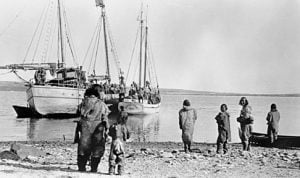
People & Culture
Losing track: The importance of passenger rail corridors
What does it mean for Canada if we continue to pull up train tracks?
- 4438 words
- 18 minutes
This article is over 5 years old and may contain outdated information.
Mapping

Old maps are fascinating in part because they can tell us not only how people once saw the world but also how that world was shaped. That’s certainly true of the railway maps shown below, whether it’s the scarlet-lettered 1880s-era map of the Grand Trunk Railway or the map of the Maritimes targeted at “business-men, tourists and sportsmen.”
Here’s a brief explanation of four of these maps, provided by Sara Viinalass-Smith, an early cartographic archivist with Library and Archives Canada.

This map features information on rail and ship transportation, mining and where to find wildlife for hunting and fishing in the Maritimes. For example, the * symbol on the map represents moose and caribou hunting locations. The map also allowed those using it to locate iron, gold and coal mines, as well as mineral springs, granite and gypsum. It also advises on where one can locate accommodations. Businessmen and sportsmen would have had all the information necessary for an exciting and lucrative trip to the Maritimes.

Produced for the 1857 Canadian Almanac, this map includes proposed and current railways, roads, steamer routes, canals, counties, districts and townships. Upper and Lower Canada, specifically the Great Lakes and Georgian Bay regions, are featured in Canada west. The two vignettes depict a train and a coat of arms.

This coloured bird’s-eye view map was produced for the Canadian Pacific Railway Company Passenger Department in 1915. The pictorial map on the right shows the Laurentian Mountains with a red line running through them, perhaps indicating the CPR rail line serving the area. To the left is a topographic map of the Gatineau Valley.


The Canadian Pacific Railway originally produced this two-sided map as an informational pamphlet, probably around 1892. The front shows the CPR’s lines and connections in the area of Canada and United States between the latitudes of about 38 degrees north and about 54 degrees north, while the reverse lists regulations governing homesteads, lands, immigration and settlers’ effects — important information, perhaps, for those wishing to settle in Canada.
Are you passionate about Canadian geography?
You can support Canadian Geographic in 3 ways:

This story is from the July/August 2015 Issue

People & Culture
What does it mean for Canada if we continue to pull up train tracks?

Travel
The trail started with a vision to link Canada coast to coast to coast. Now fully connected, it’s charting an ambitious course for the future.

Mapping
Notable works capture the danger and drama of Arctic exploration

Exploration
A century after the start of the thrilling expedition that strengthened claims to Canadian sovereignty in the Arctic, the first Canadian Arctic Expedition remains a largely unknown part of the country’s history